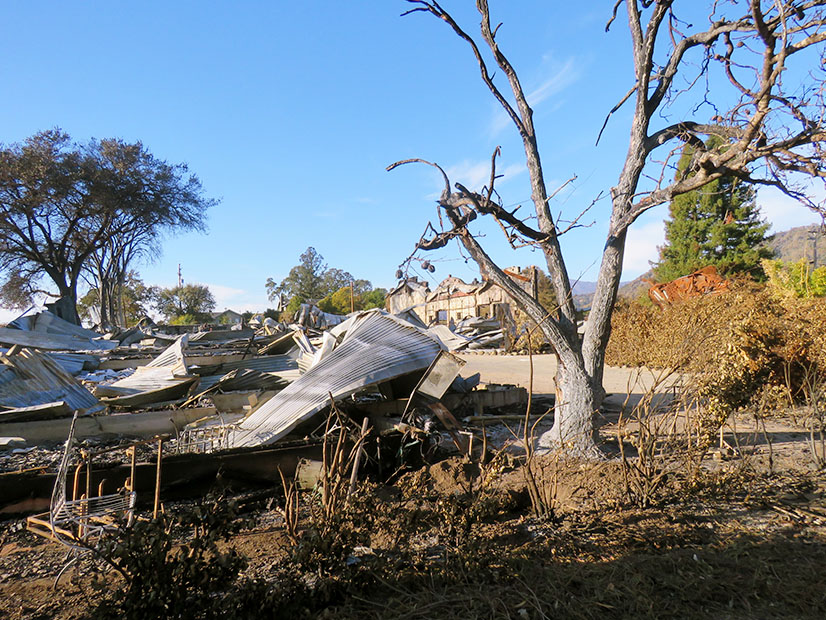
The California Public Utilities Commission on Thursday adopted fines and penalties of $125 million against Pacific Gas and Electric for starting the 2019 Kincade Fire, using a new enforcement tool that caused unusual discord among the CPUC’s five commissioners, who tend to vote unanimously.
The new expedited enforcement measure, called an administrative consent order (ACO), is a settlement process intended to reduce the time it takes the CPUC to hold utilities accountable for safety violations in an era of catastrophic wildfires. Other enforcement proceedings, such as the commission’s order instituting investigation, can take years to complete.
The CPUC created its new mechanism in November 2020 when it adopted a revised policy to promote timely enforcement of safety violations.
“The addition of these tools to the CPUC’s enforcement options in 2020 moved the CPUC’s practices more in line with the enforcement practices of many other state and local enforcement agencies,” the commission said in a statement last month.
The CPUC used its ACO option for PG&E in the Kincade Fire and for Southern California Edison (SCE) in the major fires of 2017/18, including the Thomas and Woolsey fires. The CPUC was set to take up an agreement with SCE to impose $550 million in fines and penalties for the catastrophic blazes on Thursday but moved the matter to its Dec. 16 voting meeting pending further review.
Commissioners voted 3-2 to approve the agreement between PG&E and the CPUC’s Safety and Enforcement Division that levied $40 million in fines and denied the utility $85 million in cost recovery for removing abandoned transmission lines.
A disused but energized transmission line leading to The Geysers, Calpine’s 650-MW geothermal plant in Sonoma and adjoining counties, started the Kincade Fire when a jumper cable broke, sparking dry vegetation below, an investigation by the California Department of Forestry and Fire Prevention found. The blaze burned nearly 78,000 acres of the region’s forested hills and famed wine country, destroying 374 structures and injuring four firefighters.
PG&E faces a criminal prosecution and lawsuits the utility estimated could cost up to $800 million over the Kincade Fire. It settled claims with Sonoma County and four cities affected by the fire for $31 million in May. (See Prosecutors Charge PG&E for 2019 Kincade Fire and Wildfire Liability, Criminal Charges Cloud PG&E Outlook.)
The agreement between PG&E and the CPUC settles only the claims of state regulators.
Commissioners at Odds
Commissioners Darcie Houck and Genevieve Shiroma, who voted against the order, said they agreed with commenters such as The Utility Reform Network that the matter deserved a longer and more in-depth public airing.
Houck noted that PG&E’s equipment caused the San Bruno gas pipeline explosion in 2010 and a series of catastrophic wildfires over the last seven years that killed more than 100 people. The CPUC has repeatedly criticized PG&E in official letters for its alleged safety failures, including five times in the past year alone, she said. (See CPUC Applies New Safety Metrics to PG&E.)
“Given the number and severity of these events, I believe that we should be providing greater scrutiny to the proposal before us,” Houck said.
“Investigation and resolution of a large-scale utility-caused disaster through a black-box settlement and resolution outside of a more formal process … is concerning to me,” she said. “It excludes impacted communities, ratepayer advocates and the public from being able to provide meaningful input up front as to the reasonableness of the proposal, potential rate implications and recommendations … [about] changes in utility operations.”
Those who voted for the agreement said they believed it achieved a just result in far less time than the CPUC’s traditional investigation and enforcement process.
“When it comes to our enforcement actions, I have been very troubled by the time that it takes, in some cases five to six years … and I’m not sure that’s doing quite as much justice as something that is akin to what’s before us, which is far more prompt and what I think is a fair outcome,” Commissioner Martha Guzman Aceves said.
CPUC President Marybel Batjer and Commissioner Clifford Rechtschaffen joined her in voting for the ACO.
“With the adoption of the administrative consent orders as part of our enforcement policy, this was a step forward in giving our expert safety and enforcement staff new tools to bring timely enforcement actions, all with the intention of driving accountability from the utilities and in the end to create a more-safe system for our customers,” Batjer said.
PG&E Disputes Allegations
The CPUC did not require PG&E to admit to any safety violations as part of the agreement.
The three main violations that formed the basis of the agreement included allegations by the CPUC’s Safety and Enforcement Division (SED) that PG&E had disconnected one of its lines from a mothballed portion of The Geysers plant but had “left the jumper cables on [one tower] attached to the ends of suspension insulators that were hanging freely from the tower arm.” That “allowed for more than typical movement of the suspension insulator string” causing the jumper cable to wear and break loose, the CPUC said.
“Accordingly, SED asserts the Geysers #9 line, as left by PG&E, was not constructed, or maintained, for its intended use,” the agreement said.
PG&E denied the allegations, contending, for example, that prior to the Kincade Fire, there were “no engineering standards, design drawings or guidance documents in the transmission industry that referenced the specific [tower] jumper configuration or that recommended or discouraged that specific configuration.”
The company said in a statement last week that it had accepted the settlement because it would allow “all parties to move forward from the fire and permit us to focus on compensating victims and making our energy system safer.”
